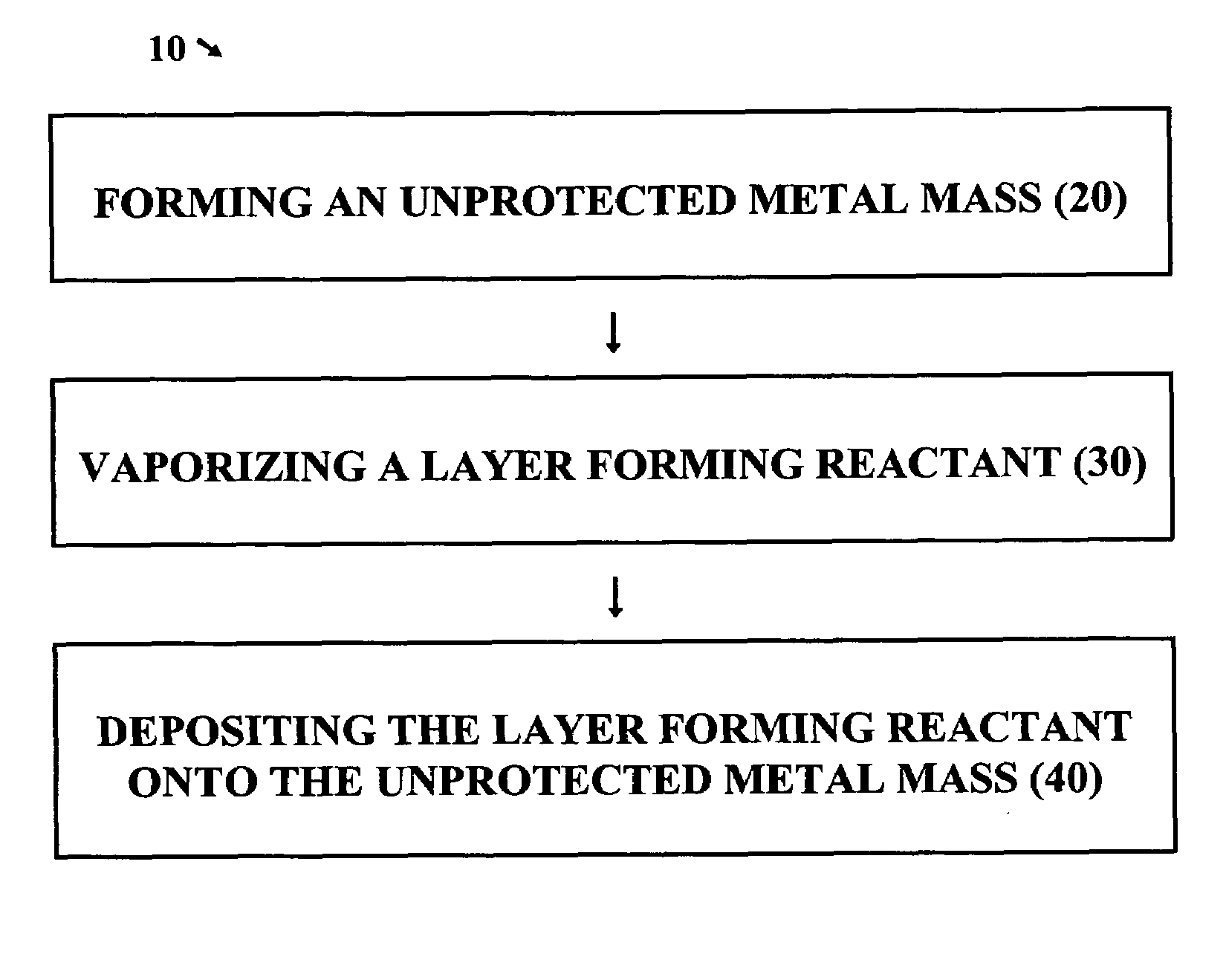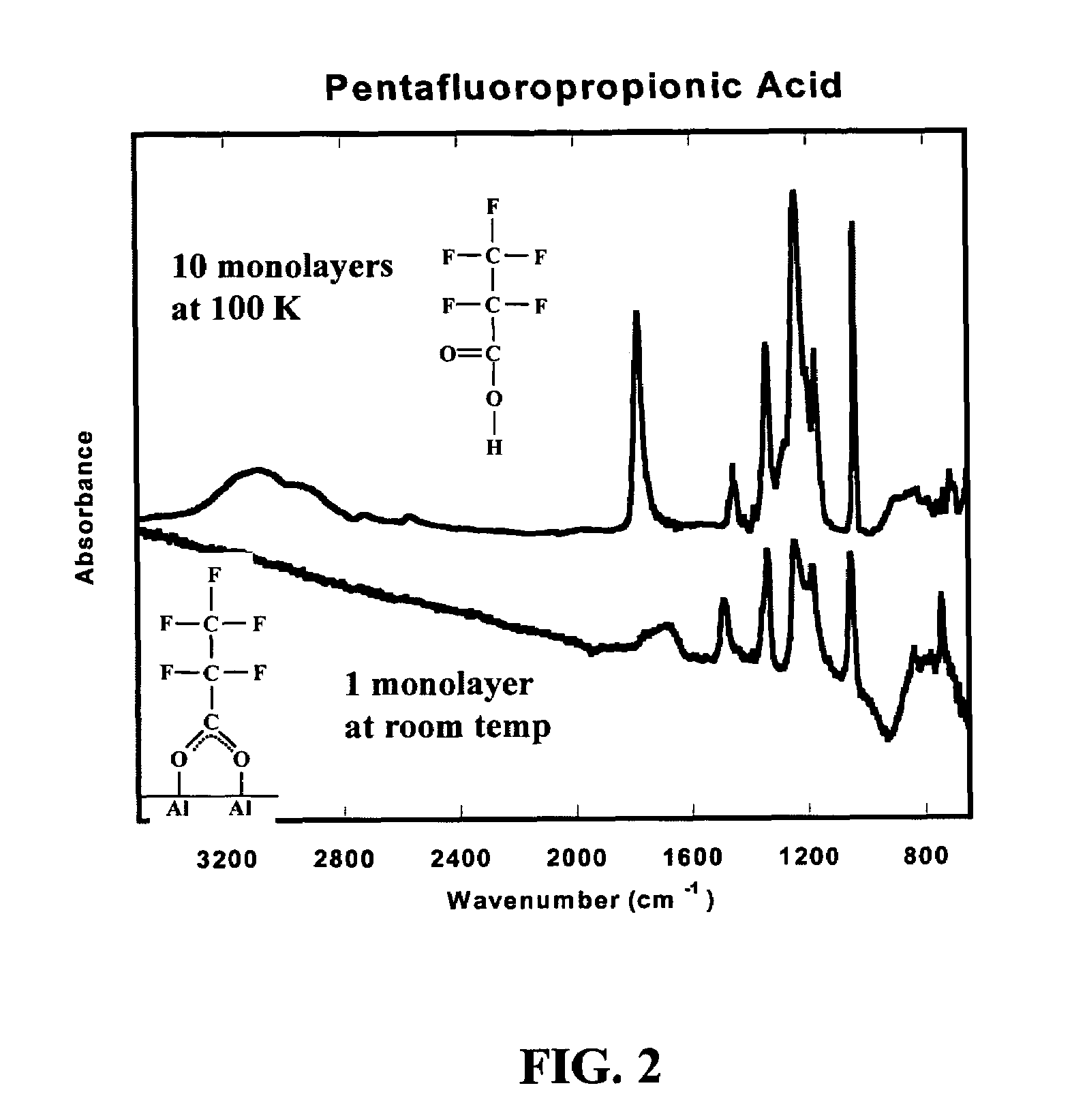Inhibition of aluminum oxidation through the vapor deposition of a passivation layer and method thereof
- Summary
- Abstract
- Description
- Claims
- Application Information
AI Technical Summary
Benefits of technology
Problems solved by technology
Method used
Image
Examples
example 1
Metal Surface
[0021]Vapor deposition of CF3CF2COOH (“C3F5O2H”) onto an Al (111) surface was performed under a vacuum of 1×10−10 Torr. The aluminum surface was sputter cleaned with 1 KeV Ar+ ions and annealed at a temperature of 800 K, with the elemental cleanliness of the surface verified with X-ray photoelectron spectroscopy (XPS). The passivating layer of either C3F5O2H or CH3CH2O2H was introduced into the vacuum chamber as a vapor, which passivated the aluminum surface and prevented its further oxidation upon exposure to oxygen and / or water. X-ray photoelectron spectroscopy (XPS) was used to provide a compositional analysis of the passivation and functional layer of the nanoparticle surfaces. The characterization of surface bonding and adsorbate orientation was accomplished by IRRAS (infrared reflection absorption spectroscopy) as demonstrated by FIGS. 2 and 3. FIG. 2 shows the spectrum for C3F5O2H that was vapor deposited on the aluminum (111) surface at 100 K (an effective physi...
example 2
Metal Nanoparticles
[0022]Metal nanoparticles like nano-aluminum, available through vapor phase synthesis, etc., are coated through a vaporization process with a passivation layer which inhibits the oxidation of the metal. Currently in the vapor phase synthesis of metals, an inert gas condensation process is used to form and tailor the size of the metal particles. Following the gas condensation process, oxygen is introduced to passivate the metal surface. Instead, a vapor containing C3F5O2H and / or CH3CH2O2H along with the inert gas can be introduced to form a passivation layer, which inhibits oxidation of the metal (see FIG. 1). The vapor containing a carboxylic acid such as C3F5O2H and / or CH3CH2O2H can also be used to passivate the metal after the metal particles are formed but before oxygen is introduced to passivate the metal.
example 3
(Prophetic) Electronic Wiring
[0023]Nano-scale or micron-scale electronic wiring is coated with a passivation layer, such as C3F5O2H and / or CH3CH2O2H, onto an oxide-free or partially oxidized metal surface. The protective coating on the metal wire prevents its corrosion and oxidation. It would be beneficial in between small-spaced wires where oxidation or continued oxidation of the wiring would cause the wires to come in contact with one another thus causing a failure or changing the electrical behavior of the electronic device (e.g., capacitance or resistance). The coating maintains spacing between the wires that is small enough that oxidation of the wiring would cause the wires to come into contact with one another or change electrical or thermal conductivity. The coating maintains the spacing of the wiring, contacts, interconnects, as well as thermal and electrical conductivity of the wiring, contact and interconnects.
PUM
| Property | Measurement | Unit |
|---|---|---|
| Thickness | aaaaa | aaaaa |
| Thickness | aaaaa | aaaaa |
| Nanoscale particle size | aaaaa | aaaaa |
Abstract
Description
Claims
Application Information
 Login to View More
Login to View More - R&D
- Intellectual Property
- Life Sciences
- Materials
- Tech Scout
- Unparalleled Data Quality
- Higher Quality Content
- 60% Fewer Hallucinations
Browse by: Latest US Patents, China's latest patents, Technical Efficacy Thesaurus, Application Domain, Technology Topic, Popular Technical Reports.
© 2025 PatSnap. All rights reserved.Legal|Privacy policy|Modern Slavery Act Transparency Statement|Sitemap|About US| Contact US: help@patsnap.com



